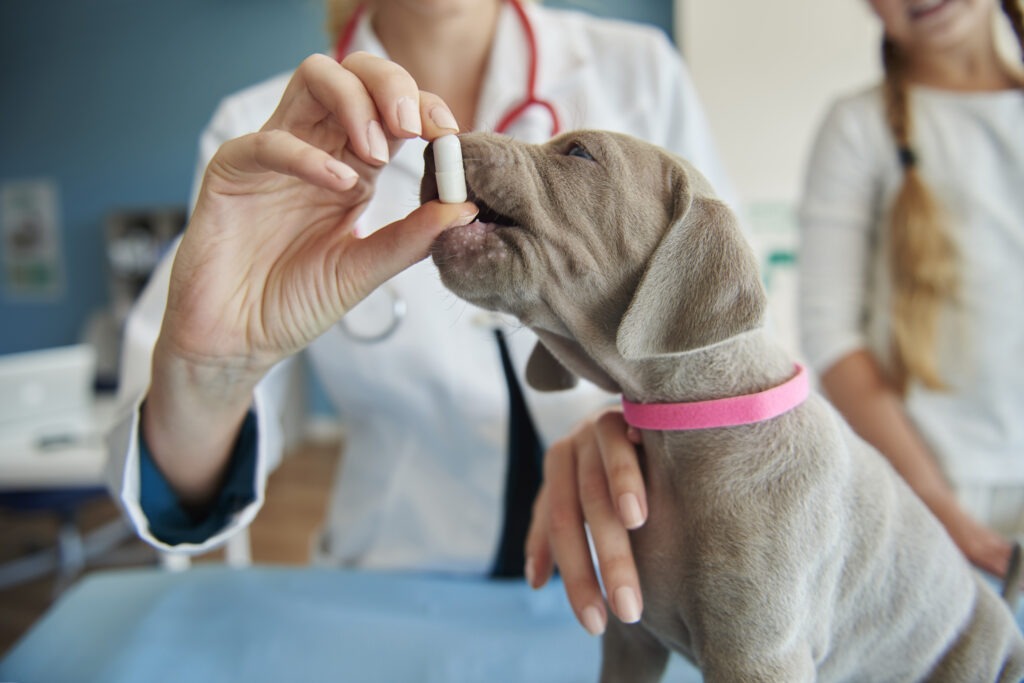You see your dog limping, whining, or just not acting like their usual self. Maybe they’re lying still in their bed when they’d normally jump around. Or they don’t want to eat. You’re asking yourself:
“What can I give my dog for pain?”
That’s the right question — and asking it means you care deeply.
This guide is written just for you — the everyday dog owner who isn’t a vet, but wants to do the right thing. Let’s go step by step.

The Big Rule: Never Guess or Gamble with Meds
The danger with human medicine
You might be tempted to give your dog something from your cabinet, like:
Don’t do it. Even one pill can be toxic. Your dog’s body isn’t built like yours. These meds can cause:
- Kidney failure
- Liver damage
- Internal bleeding
- Death in severe cases
So if you’re asking what human medicine is safe for dogs, the safest answer is: None, unless a vet tells you exactly what to give and how much.
First, Learn How Dogs Show Pain
Dogs can’t say “it hurts,” so they show it in other ways. Watch for signs like:
- Limping or not using one leg
- Hiding or acting distant
- Whining or whimpering
- Not eating or drinking
- Heavy breathing or panting
- Biting when touched
- Not wanting to be picked up
If your dog is showing even two or three of these signs, it’s time to take action — safely.
What Can I Give My Dog for Pain? Start with the Vet
The only safe way to give your dog medicine for pain is to get it from a licensed veterinarian.
They’ll consider:
- Your dog’s weight
- Age and breed
- Any other health problems
- What’s causing the pain (arthritis? injury? surgery?)
Then they’ll give you a specific medication at the right dose.

The Most Common Vet-Approved Pain Meds for Dogs
Here’s a clear, friendly dog pain medication guide to help you understand what your vet might prescribe:
Dog-Specific NSAIDs (Non-Steroidal Anti-Inflammatory Drugs)
These are like Advil — but made for dogs. They help with swelling, stiffness, and pain.
| Drug Name | What It Does | Notes |
|---|---|---|
| Carprofen (Rimadyl) | For arthritis, injury, or surgery pain | Most common dog NSAID |
| Meloxicam (Metacam) | Liquid or pill | Good for small dogs |
| Firocoxib (Previcox) | Daily chew | Often for joint or bone issues |
| Deracoxib (Deramaxx) | Strong anti-inflammatory | Often used after surgery |
| Grapiprant (Galliprant) | Newer option | Gentler on stomach and kidneys |
Side Effects to Watch
Even vet meds can cause issues like:
- Vomiting
- Diarrhea
- Tiredness
- Loss of appetite
If you notice these, stop the meds and call your vet.
Other Vet Meds for More Serious Pain
If NSAIDs aren’t enough, the vet might try:
🔹 Gabapentin
Used for nerve pain. Often combined with other meds. May cause sleepiness at first.
🔹 Tramadol
A mild opioid for short-term pain. Not used as much now, but still common after surgery.
🔹 Librela
New monthly shot for arthritis pain. Easy for older dogs. Ask your vet if it’s right.
What to Give a Dog for Pain Relief at Home (Without Medicine)
Sometimes your dog’s pain is mild. Or maybe you’re waiting for a vet appointment. Here’s how to give pain relief for dogs at home — no pills needed.
Comfort Tips:
- Use a soft, orthopedic dog bed
- Avoid stairs and jumping
- Use ramps to beds or couches
- Keep them warm and cozy
- Avoid too much exercise
Home Remedies for Dog Pain:
These won’t cure anything, but they can help ease the pain safely.
- Omega-3 supplements
Help with joint support and inflammation. - CBD for dogs
Can calm pain and anxiety — but ONLY use vet-approved brands. - Massage and gentle movement
Light petting or short walks can loosen stiff muscles. - Turmeric (with vet approval)
Natural anti-inflammatory — check dose with your vet. - Glucosamine & Chondroitin
Joint supplements found in chewable treats or powder.
Remember: even if you’re using home remedies for dog pain, always monitor your dog and check in with your vet if things don’t improve.
You may like – What Painkillers Can I Give My Dog? A Simple And Safe Guide for You

OTC Pain Meds for Dogs — Are Any Safe?
If you’re searching for OTC pain meds for dogs, here’s the truth:
- There are NO human OTC pain meds that are safe for dogs without vet supervision.
- Some dog-specific OTC supplements (like joint chews) are safe, but they’re not for emergency pain relief.
- Always read the label and never dose based on guesswork.
So if you’re asking what OTC pain meds for dogs are safe — the answer is: Only the ones your vet says are okay.
What to Do in an Emergency
If your dog is in sudden pain and you can’t see the vet right away:
Emergency Plan:
- Keep your dog still and quiet
- Don’t feed them any food or meds
- Offer water if they want it
- Call your vet or emergency pet clinic
- Describe the symptoms clearly
- Follow instructions exactly
DO NOT give aspirin, Tylenol, Advil, or other human meds “just in case.” You could cause serious harm.

Quick FAQ:
What human medicine is safe for dogs?
None — unless a vet tells you the exact drug and dose.
How to treat dog pain at home?
Use soft bedding, warmth, joint supplements, and rest. No meds unless approved.
Is dog pain relief without vet possible?
You can give comfort and support, but not medicine without vet help.
Are there OTC pain meds for dogs I can buy?
Only vet-approved dog meds. Human OTC drugs are NOT safe.
What’s the best pain relief for dogs at home?
A cozy bed, joint supplements, gentle movement, and warmth.
What home remedies for dog pain work?
CBD, omega-3s, turmeric, massage — all vet-approved.
What’s the best medicine for dog pain?
Carprofen, Meloxicam, or Gabapentin — depending on your vet’s advice.
What to give a dog for pain relief that’s safe?
Only what your vet recommends — no guessing.
Action Plan: What You Should Do Right Now
- Watch your dog closely — note any limping, crying, or mood changes.
- Don’t give any human medicine.
- Call your vet and book an exam if pain lasts more than a day.
- Ask your vet: What can I give my dog for pain safely?
- Follow the dosage exactly.
- Support your dog at home with soft bedding, ramps, supplements, and love.
Final Thoughts: You’re Doing the Right Thing
If you made it this far, here’s what you should know:
You’re not just asking what can I give my dog for pain — you’re showing up with love, care, and a desire to do what’s right.
By learning, asking questions, and making safe choices, you’re giving your dog the best possible chance to feel better and heal.
And that’s what being a good pet parent is all about.
Share To Help